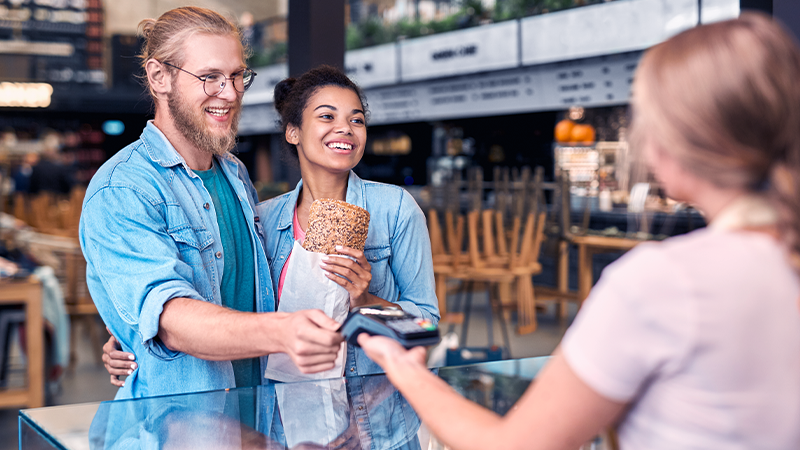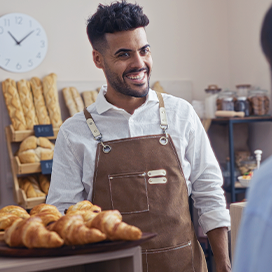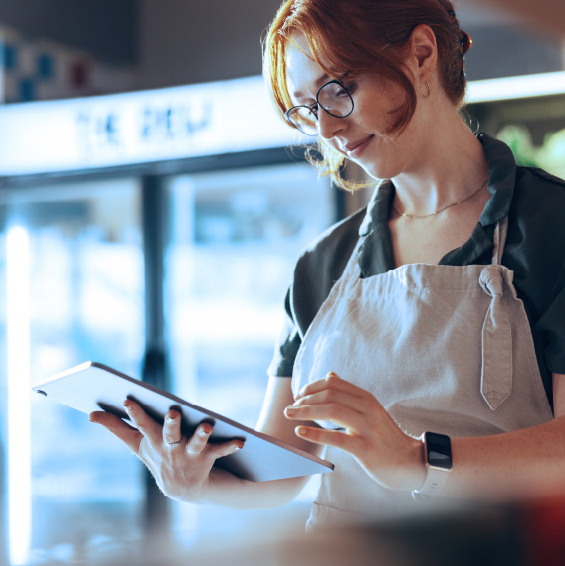
Turn bar first-timers into regulars with seamless payments
Learn how seamless payments, loyalty programs and personalized service can turn first-timers into regulars.

It’s 8 a.m. at a bustling corner café. The morning rush is in full swing, customers want their coffee fast, staff are stretched thin, and the owner is already worried about rising supply costs and whether there are enough hands to cover the lunch shift. Add in the pressure of keeping orders accurate, meeting health and safety standards, and knowing that every customer might leave a review online, and the stress can pile up quickly. With so many hurdles to clear, your point-of-sale (POS) system shouldn’t be another one. It should simply work. For a single-location restaurant, the right POS is more than just a payment tool. It is the steady hand that keeps service flowing, ensures the details do not get lost, and helps turn daily chaos into consistency.
So how do you choose the right one? What does the right POS system actually look like for a small quick service restaurant that has a single location only? It is not about having every feature under the sun. It is about choosing the tools that match the pace and size of your business. From faster checkouts to clearer kitchen communication, the right system is built to solve everyday headaches and keep things running smoothly. Here is what to look for, and why each feature can make a real difference for your restaurant.
Let’s break down the essentials with real, easy-to-picture examples:
What it is: A system designed for the fast-paced world of quick service, where customer queue management is critical and orders need to be entered and processed in seconds.
Why it matters: Unlike POS systems meant for full-service restaurants, a QSR POS is built to keep up with short bursts of traffic, like lunchtime rushes or morning coffee runs.
Example: At a university café, students queue between classes with less than two minutes per transaction. A QSR POS speeds up payments so “latte-line” delays don’t stall the rush.
What it is: Options to personalize your POS interface so it works the way your team does. This includes customizing screen colors, arranging item and category placement, using global search to quickly find any menu item, and adding open-priced items for flexibility.
Why it matters: A well-organized POS screen speeds up service and reduces errors. Features like global search make it easy to find items across categories, and open-priced items are perfect for businesses like bakeries that offer custom products with variable pricing.
Example: Your bakery takes custom cake orders with different prices. Instead of creating a new menu item for every variation, you use the open-priced item feature to enter the exact amount at checkout—keeping things simple and fast.
What it is: Detailed data on sales and performance trends.
Why it matters: You can’t improve what you don’t measure. With reporting, you see exactly which items are selling well and when your busiest times occur.
Example: A smoothie bar notices that green smoothies sell out during late afternoons. Thanks to reporting, you adjust prep schedules to meet demand and reduce waste.
What it is: Orders flow directly from the POS to the kitchen. No middleman, no confusion.
Why it matters: Shouting orders or passing scribbled notes isn’t always efficient. A streamlined POS keeps the front-of-house and kitchen in perfect sync.
Example: At your poke bowl counter, staff enter “Tuna, extra avocado, light rice” into the POS. The kitchen sees the exact instructions instantly—no topping mix-ups.
What it is: Access to help when something goes wrong, whether it’s troubleshooting, training, or upgrades.
Why it matters: Downtime is deadly for a small QSR. Every minute the POS is down, customers and sales are lost.
Example: If face any issues during your busy shift, you can reach out for assistance and get guidance to resolve the issue.
Want to see how these features work in real life? Explore Moneris Go Restaurant and discover how it can simplify your day-to-day.
What it is: A simple, visual snapshot of your daily, weekly, or monthly sales.
Why it matters: Instead of digging into reports, you get a quick overview of how the day is going. This is perfect for owners juggling multiple responsibilities.
Example: At your bubble tea shop, you check the dashboard at 2 p.m. and see that sales are significantly higher than yesterday. You decide to keep one extra staff member for the evening rush.
What it is: Access to your business data from any device with an internet connection.
Why it matters: You don’t need to be in the restaurant to stay informed. While reports are best viewed on a desktop for now, you can still log in remotely to check performance.
Example: You’re away at a family event but log in from your laptop and notice sales are slower than usual for a Thursday. You decide to post a quick social media promo to bring in more customers.
What it is: The ability to manually add, remove, or adjust menu items and prices.
Why it matters: Small QSRs often rotate specials or seasonal items, and you need a POS flexible enough to keep up.
Example: Your café decides to run a limited-time maple latte for fall. You add it to the POS in seconds and mark it inactive when the promotion ends—no need to delete and re-add later.
What it is: Dependable printers designed to integrate with POS systems, producing clear, fast receipts and kitchen tickets.
Why it matters: Receipts keep customers happy (and your records straight), while kitchen tickets keep chefs on track.
Example: A busy lunch crowd orders sandwiches back-to-back. The printer churns out clear kitchen tickets without paper jams, keeping the sandwich station moving smoothly.
What it is: Control over what each employee can access on the POS.
Why it matters: Protects sensitive data and prevents errors. Not everyone needs access to refunds or discounts.
Example: At your shawarma spot, cashiers can process orders and payments, but only managers can authorize discounts. This keeps your finances secure and your team accountable.
What it is: A digital screen that replaces paper tickets, showing all incoming orders in real time.
Why it matters: Cuts down on clutter, reduces mistakes, and makes it easier for kitchen staff to prioritize orders.
Example: Your burger joint has a tiny prep area. Instead of paper slips piling up, the KDS shows each order clearly, colour-coded by status (new, in progress, ready). Staff stay organized even during the rush.
For a small, single-location QSR nestled in a strip mall, university building or mini shopping centre, a purpose-built POS is far more than a cash register. It’s the system that keeps your orders efficient, your team in sync, your menu flexible, and your profits measurable.
If you want to thrive in a challenging market, a smart POS is your secret ingredient.
Ready to streamline your café or small restaurant? Explore Moneris Go Restaurant today and see how the right POS can transform your business.

Learn how seamless payments, loyalty programs and personalized service can turn first-timers into regulars.

Learn why a POS system is essential for small quick service restaurants and which features help streamline orders, boost sales, and keep your café running smoothly.

Discover the best POS systems for small retail businesses. Learn how to streamline inventory, boost sales, and improve customer service with the right POS solution.

Learn what card testing fraud is, how it targets your e-commerce site, and the best practices you can use to detect, block, and prevent attacks before they impact your business.